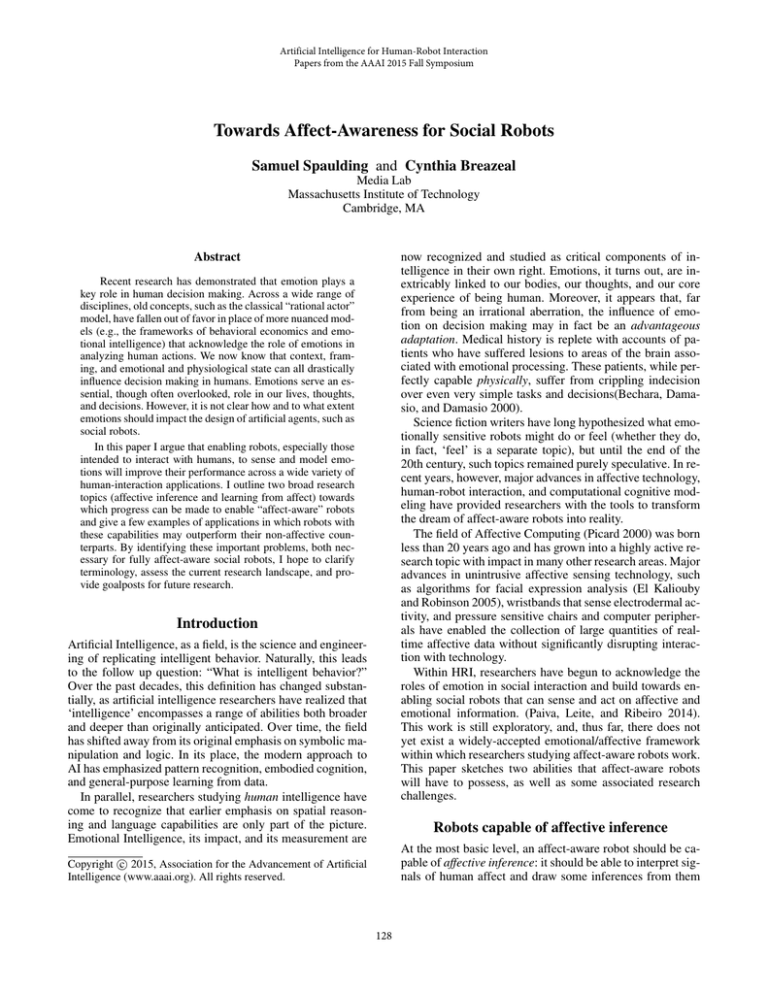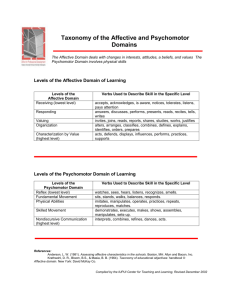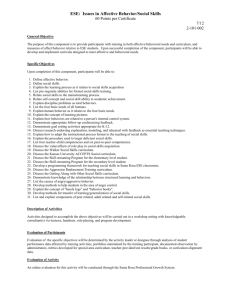
Artificial Intelligence for Human-Robot Interaction
Papers from the AAAI 2015 Fall Symposium
Towards Affect-Awareness for Social Robots
Samuel Spaulding and Cynthia Breazeal
Media Lab
Massachusetts Institute of Technology
Cambridge, MA
Abstract
now recognized and studied as critical components of intelligence in their own right. Emotions, it turns out, are inextricably linked to our bodies, our thoughts, and our core
experience of being human. Moreover, it appears that, far
from being an irrational aberration, the influence of emotion on decision making may in fact be an advantageous
adaptation. Medical history is replete with accounts of patients who have suffered lesions to areas of the brain associated with emotional processing. These patients, while perfectly capable physically, suffer from crippling indecision
over even very simple tasks and decisions(Bechara, Damasio, and Damasio 2000).
Science fiction writers have long hypothesized what emotionally sensitive robots might do or feel (whether they do,
in fact, ‘feel’ is a separate topic), but until the end of the
20th century, such topics remained purely speculative. In recent years, however, major advances in affective technology,
human-robot interaction, and computational cognitive modeling have provided researchers with the tools to transform
the dream of affect-aware robots into reality.
The field of Affective Computing (Picard 2000) was born
less than 20 years ago and has grown into a highly active research topic with impact in many other research areas. Major
advances in unintrusive affective sensing technology, such
as algorithms for facial expression analysis (El Kaliouby
and Robinson 2005), wristbands that sense electrodermal activity, and pressure sensitive chairs and computer peripherals have enabled the collection of large quantities of realtime affective data without significantly disrupting interaction with technology.
Within HRI, researchers have begun to acknowledge the
roles of emotion in social interaction and build towards enabling social robots that can sense and act on affective and
emotional information. (Paiva, Leite, and Ribeiro 2014).
This work is still exploratory, and, thus far, there does not
yet exist a widely-accepted emotional/affective framework
within which researchers studying affect-aware robots work.
This paper sketches two abilities that affect-aware robots
will have to possess, as well as some associated research
challenges.
Recent research has demonstrated that emotion plays a
key role in human decision making. Across a wide range of
disciplines, old concepts, such as the classical “rational actor”
model, have fallen out of favor in place of more nuanced models (e.g., the frameworks of behavioral economics and emotional intelligence) that acknowledge the role of emotions in
analyzing human actions. We now know that context, framing, and emotional and physiological state can all drastically
influence decision making in humans. Emotions serve an essential, though often overlooked, role in our lives, thoughts,
and decisions. However, it is not clear how and to what extent
emotions should impact the design of artificial agents, such as
social robots.
In this paper I argue that enabling robots, especially those
intended to interact with humans, to sense and model emotions will improve their performance across a wide variety of
human-interaction applications. I outline two broad research
topics (affective inference and learning from affect) towards
which progress can be made to enable “affect-aware” robots
and give a few examples of applications in which robots with
these capabilities may outperform their non-affective counterparts. By identifying these important problems, both necessary for fully affect-aware social robots, I hope to clarify
terminology, assess the current research landscape, and provide goalposts for future research.
Introduction
Artificial Intelligence, as a field, is the science and engineering of replicating intelligent behavior. Naturally, this leads
to the follow up question: “What is intelligent behavior?”
Over the past decades, this definition has changed substantially, as artificial intelligence researchers have realized that
‘intelligence’ encompasses a range of abilities both broader
and deeper than originally anticipated. Over time, the field
has shifted away from its original emphasis on symbolic manipulation and logic. In its place, the modern approach to
AI has emphasized pattern recognition, embodied cognition,
and general-purpose learning from data.
In parallel, researchers studying human intelligence have
come to recognize that earlier emphasis on spatial reasoning and language capabilities are only part of the picture.
Emotional Intelligence, its impact, and its measurement are
Robots capable of affective inference
At the most basic level, an affect-aware robot should be capable of affective inference: it should be able to interpret signals of human affect and draw some inferences from them
c 2015, Association for the Advancement of Artificial
Copyright Intelligence (www.aaai.org). All rights reserved.
128
function - one in which previous characterizations of humangenerated reward functions may not apply. Fortunately, there
are entire disciplines dedicated to understanding and characterizing human affective responses, albeit not necessarily in the context of a human-robot interaction. Researchers
should look to cognitive and affective sciences for models
characterizing affective response and affective learning.
Another challenge to affective learning lies in identifying
aspects of the reward signal common to the task state versus aspects that are unique or personalized to an individual
human teacher. Groups of humans eventually seem to converge on a small number of distinct strategies in novel agenttraining tasks. However, for everyday tasks that require
high levels of social interactivity, humans express themselves emotionally in highly personal and context-dependent
styles. Whether a computationally tractable set of affective
expressive styles can be identified and made useful to an affectively learning robot remains an open question.
Even so, it seems likely that action policies learned from
affective signals in the context of one person will not directly transfer to another person, or even the same person
in a different context. Personalized and long-term learning
models are active research topics, but there has been little
work investigating how to adapt methods from these fields to
an affective reward signal. A deeper understanding of what
aspects of the affective signals are generalizable or common
components across populations or contexts is another crucial
step towards developing robots that can learn from affect.
about the state of the world or the mental state of a human.
For example, a robot capable of affective inference working
in the domain of educational tutoring might analyze facial
expressions looking for signs of frustration, confusion, or
delight. From its affective sensing, the robot might then infer what educational concepts a child has mastered, based
on the questions answered, in order to track his/her curricular progress more accurately (Spaulding 2015).
Affective inference is, importantly, not the same as affect recognition (i.e., the ability to label emotions, for instance, by analyzing facial expressions and classifying them
as ‘happy’ or ‘sad’ or ‘surprised). Though inferential methods are often used for affect recognition, the sense in which
I use “affective inference” in this paper relies on taking the
recognition problem further, in being able to ground that label in some additional knowledge that reflects that nature of
the world. A robot capable of affective inference should possess some knowledge (either learned or programmed) about
what ‘happy’ facial expressions indicate about the world or
a human user. Robots capable of affective inference will be
better able to interpret and understand their users’ actions,
build better models of their users, and better predict how
those users may act in the future.
Robots capable of learning from affect
Building on top of ability to draw inferences from affective
information is the capability to learn from affective data. Because emotions form an important part of the state of the
world, it is necessary to consider how emotion could be used
to help shape or guide robot actions. Generally speaking, almost all learning algorithms use features extracted from raw
sensory data to identify patterns and structure. We know that
affective features are highly salient for humans: we unconsciously mirror others’ affective states, we choose what to
say or do, in part, based on our understanding of others’ affective state, and many of our most fundamental social learning processes are mediated by affective signals. Thus, one
path towards developing robots capable of social learning or
social interaction is studying how to enable a robot to learn
from affective signals by adapting modern machine learning
methods to handle affective features.
Affective signals can be considered a type of humangenerated training signal. Learning from human-generated
reward is an active research topic within the HRI and Intelligent Agent communities. However, this work typically deals
with consciously-awarded human-generated reward, often in
the form of “clicker training.” A significant amount of research in this area is dedicated to understanding and characterizing the nature of the human-generated reward signal to
design learning algorithms better suited for these classes of
reward functions.
One challenge in enabling robots to learn from affect is
that, in some cases, affective reward signal (e.g., reward for
smiling/frowing or other genuine facial expressions, or reward based on galvanic skin response) is not consciously
given. In this respect, using affective response as reward
stands in contrast to other, more studied, channels of humangenerated reward. It is likely, therefore, that unconscious affective response constitutes an entirely new class of reward
Conclusion
We are now beginning to recognize the importance of emotion in daily life and understand how affect leaves its trace
on nearly every aspect of our experience, from how we interpret social actions and events to how we literally perceive
the physical world around us (Riener et al. 2011). Advances
in cognitive neuroscience are sweeping away the old view of
a unified, rational consciousness, yet the majority of learning and action models for socially interactive robots are still
grounded in the principles of classically rational decisionmaking. The maturation of affective computing technology
now provides us with the tools and opportunity to design and
build emotionally intelligent robots. Affect-aware robots,
designed to interpret, understand, and act on what we now
know to be a fundamental aspect of human experience, will
bring us closer to a future in which our technology responds
intuitively, comfortably, and fluently.
References
Bechara, A.; Damasio, H.; and Damasio, A. R. 2000. Emotion, decision making and the orbitofrontal cortex. Cerebral
cortex 10(3):295–307.
El Kaliouby, R., and Robinson, P. 2005. Real-time inference
of complex mental states from facial expressions and head
gestures. In Real-time vision for human-computer interaction. Springer. 181–200.
Paiva, A.; Leite, I.; and Ribeiro, T. 2014. Emotion modeling for social robots. The Oxford Handbook of Affective
Computing 296.
129
Picard, R. W. 2000. Affective computing. MIT press.
Riener, C. R.; Stefanucci, J. K.; Proffitt, D. R.; and Clore, G.
2011. An effect of mood on the perception of geographical
slant. Cognition and Emotion 25(1):174–182.
Spaulding, S. 2015. Developing affect-aware robot tutors.
Master’s thesis, Massachusetts Institute of Technology.
130





